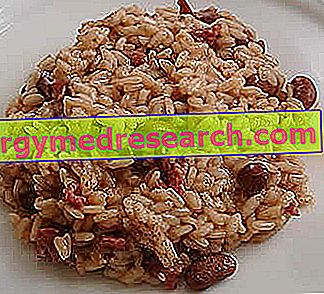Panissa is the name used to indicate even very different recipes; in particular, it is necessary to distinguish above all two types of culinary preparations:
- Piedmont Panissa (also called Lombard panissa).
- Ligurian Panissa.
Panissa Piemontese and Lombarda
Piedmont panissa is a typical dish of Vercelli, but also widespread in many provinces of the Lombardy region (especially Lodi and Pavia). In the different territories it is produced in slightly different types; note is, for example, the "paniscia" of Novara.

The main ingredient and cooking method are the same as for risottos, but it is not inconceivable that panissa was originally cooked using less valuable cereals such as millet.
The ingredients of the Piedmont panissa are: Arborio rice (or Baldo or Maratelli), dry borlotti beans typical of the area (Saluggia or Villata), onion, red Barbera wine, lard, salam dla doja (typical seasoned sausage in a terracotta container), salt and pepper.
In Lombardy, the panissa does not require the use of beans, but it requires the addition of grana cheese (graniglio lodigiano).
Other versions of panissa include (sometimes replacing other ingredients): sausage, bacon, bone and ham fat (without lard), carrots, celery, cabbage, tomato sauce, pork rind, garlic, bay leaves and rosemary.
Panissa Ligure
Ligurian panissa is a typical recipe of the Liguria region, quite different from the Piedmontese and Lombard dish of the same name. It is in fact more similar to chickpea flour, it does not include the use of extra virgin olive oil in the dough and is cooked in a pot.

NB : In Spain there is an almost homonymous dish called paniza (same name of an Iberian municipality of Aragon, even if the correlation is not known).
It is a fried fish prepared with wheat flour and chickpeas (4: 1 ratio) in which are also added slices of fried dough identical to those in Liguria.
Recipes
Panissa Piemontese Recipe Example
- Soak dry beans in cold water overnight; remove the soaking water.
- With water that is initially cold, boil a ham bone with pork rinds and bay leaves in a muffler for about two hours.
- Separate the bone, the rind and degrease the broth.
- Add the rehydrated beans to the warm broth.
- At two thirds of cooking, add the chopped vegetables.
- In a saucepan, sauté the bacon beaten with a knife, the crumbled sausage, the onion, the garlic and the rosemary leaves.
- Toast the rice, add the tomato sauce, the red wine (let it evaporate) and continue with the ham broth and the beans.
- When cooked, adjust the salt and let it rest.
Panissa Ligure Recipe Example
- Mix the chickpea flour with water and salt.
- In a saucepan, bring to a boil and thicken.
- Put the mixture in molds or soup dishes.
- Cut into slices or cubes.
- Season with extra virgin olive oil and lemon or onion juice; serve at room temperature.
- Alternatively, serve hot just made.
- Frying the pieces in abundant oil you get the so-called “slices”, very similar to the Sicilian panelle and served inside small round flat flat cakes without slices (slices with fugassette).
Nutritional Comment
Panissa Piemontese and Lombarda
That of Piedmontese and Lombard panissa is a fairly energetic recipe.
By replacing the oil or butter with lard or salami, a percentage of lipids similar to that of a common risotto is obtained; moreover, the presence of beans contributes to further reducing the density of caloric nutrients, increasing the quantity of fiber.
The energy of Piedmontese and Lombard panissa is provided above all by carbohydrates, followed by lipids and finally by proteins.
Carbohydrates are mainly complex (starch), monounsaturated fatty acids (if the pig is light and farmed) or saturated (if the pork is heavy and "homemade"). Peptides are of high biological value, as they come from both meat and beans / rice association.
Cholesterol is more than relevant.
As far as vitamins are concerned, thiamine (B1) and niacin (PP) prevail, although visible in medium quantities. Analyzing the minerals, discrete concentrations of potassium, slightly bioavailable iron and calcium are observed (especially in the recipe with grana).
Piedmontese and Lombard panissa can be used in almost all diets, except those for the clinical nutrition of large obese people and those suffering from severe metabolic disorders.
It is not tolerated by vegan and vegetarian philosophy.
It lends itself to the diet of celiac and lactose intolerant (if it does not contain cheese).
Panissa Ligure
Ligurian panissa is a fairly healthy food, with a moderate caloric intake mainly provided by carbohydrates, followed by lipids (if it is seasoned or fried before consumption) and finally by proteins.
Carbohydrates tend to be complex (starch), monounsaturated fatty acids (oil) and peptides of medium biological value.
Fibers are abundant and cholesterol is absent.
Regarding vitamins, good amounts of thiamine (B1), niacin (PP) and retinol equivalent (A) are observed. As far as minerals are concerned, there are moderate concentrations of potassium, slightly bioavailable iron, calcium and phosphorus.
Ligurian panissa lends itself to any diet, but it is advisable to reduce portions in case of hyperglycemia, type 2 diabetes mellitus and hypertriglyceridemia.
It is tolerated by vegetarian and vegan philosophy.
It lends itself to the diet of celiac and lactose intolerant.



